Zambia is considered a kaleidoscope of vast ethnicities and cultures, with a diverse blend of over 70 different tribes, each offering a unique cultural experience. This vibrant diversity is also evident in Zambia’s culinary landscape, where each tribe adds its own unique flavors, cooking techniques, and food traditions, resulting in a rich embroidery of flavors that symbolize the depth and vibrancy of Zambian cuisine.
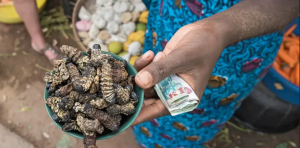
Food is considered a major part of traditional and modern Zambian culture as all Zambians share this intense pride over their love for local dishes and are often more than willing to showcase their cuisine to the rest of the world. A popular phrase used by Zambians about their food is, ‘Zambia kuchalo,’ which means, ‘Zambia to the world!’ This is proof of the local’s confidence in showcasing their local cuisine to visitors.
Zambians pride themselves on the variety of traditional food that has been handed down for generations. The country’s cuisine is unified by various staple foods, with disparities manifesting majorly in cooking techniques that differ by region. This is considering that Zambia’s tropical climate promotes the cultivation of a wide range of crops that contribute to the local cuisine. Street vendors, as well as markets, are well-stocked with fresh vegetables and foraged wild greens.
Popular meals in Zambia
Maize is Zambia’s staple food, as it’s mostly used to make popular traditional meals served across Zambia. For instance, popular meals such as nshima, samp, and munkoyo are all made from maize. Other meals that you must try whilst in Zambia include; ifinkubala (caterpillars), chikanda (polony), ifishashi, and fish.
1. Nshima
You cannot visit Zambia without tasting some delicious nshima. It is a common dish shared by every ethnic group in the nation. Some popular question that the locals are likely to ask when you visit this beautiful country is ‘Have you ever tasted nshima?’ and ‘Can you cook nshima?’
Nshima is made by mixing finely ground maize flour with hot water until you end up with a very thick porridge. Once ready, nshima is commonly served with ndiwo, a rich and tasty stew comprising fish or meat, and one or two variants of vegetables, including chibwabwa (pumpkin leaves). Nshima can be cooked at home, at food stalls, or in restaurants. However, in traditional homesteads, cooking this delicacy is a much longer process, as it involves drying the maize, sorting and grounding the kernels, and preparing the meal.
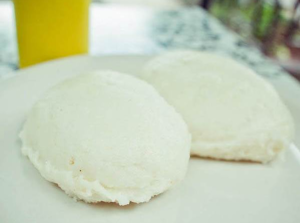
To enjoy this meal, one simply pulls off a small chunk of nshima, massage it into a ball, then press it into a scoop or spoon shape so that it may carry the side dishes. In Zambia, nshima is like a religion as most households eat it at least once a day, some as often as three times a day. Locals believe that nshima is the only meal capable of filling them up and giving them the energy they need to go about routine activities.
2. Ifinkubala
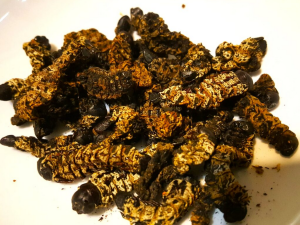
Ifinkubala is a delicacy that involves cooking Mopane Worms, either by frying them in oil, or boiling them for a few minutes then frying them in oil. Once ready, the dish can either be served with nshima, aalongside tomatoes and onions, or eaten as a snack. The worms are harvested twice a year, depending on the season. Once harvested, the worms are squeezed to remove gut contents, parboiled, and dried before they are sold at food stalls and markets.
3. Fish
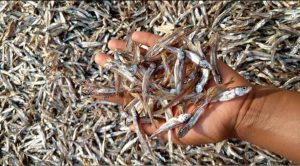
Despite being a land-locked country, Zambia’s numerous water bodies continue to serve as great sources of different types of fish, that add to the nation’s food culture. One of the most popular fish eaten by Zambians are kapenta (small sardine-type fish), which are fried win oil with onions and tomatoes. Other popular species are buka buka (Nile perch) and bream which are either dried, boiled, or grilled, and served in gravy with nshima.
4. Vitumbuwa
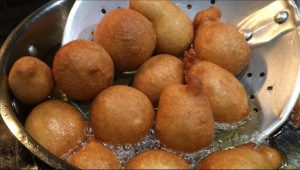
Vitumbuwa, also known as fritters, are a popular tea-time snack made from yeast, sugar, flour, and water. These yummy, donut-like delicacy can either be prepared in the house or sold as street food.
5. Ifisashi
Ifisashi is a traditional Zambian dish that involves mixing vegetables, onions, tomatoes, and pounded peanuts. The vegetables can either be cassava leaves, pumpkin leaves, collard leaves, okra, or spinach. This mixture is then cooked in peanut sauce until a desired consistency is achieved.

A popular type of Ifisashi is Delele. Delele is a Zambian dish prepared with onions, tomatoes, fresh okra, and a protein of your choice. Delele means okra in Zambia, hence the name of the dish.
Popular food customs
In Zambia, sharing food goes beyond satisfying hunger; it is an act that helps foster unity and cohesion. Special occasions, community celebrations, and family gatherings are marked by the communal sharing of food, turning each meal into an opportunity to bond and share stories. With nshima as one of the most popular meals in Zambia, it is not uncommon to find Zambians enjoying a meal without using any cutlery. Similar to other cultures that opt to forego cutlery, a bonding aspect has been linked to meal times in Zambia. Meals begin with hand washing, and this often involves helping each other wash hands, where one pours water as the other washes his/her hands. This, in itself brings a certain intimacy. Each person has a plate onto which they will put their own serving of nshima and the sides available.
When you are a guest, it is not uncommon to find the mothers and children absent at the dinner table. This is because, at the Zambian dinner table, guests are shown respect by letting them share the meal with just the father or the head of the household. In some cases, guests may find themselves enjoying the meal alone.
Whether you are in a small hut or a large house, it is considered rude not to eat to your fill as much effort is used to prepare the meals. If you finish the portion given to you, the host will most likely assume you are still hungry and proceed to serve you more food. If you eat to your fill, it is okay to leave a little food on your plate. That way, the host will know you have been served well and you are satisfied.
References
Cain, S. (2024). Food Culture in Zambia. https://www.shelbycain.com/blog-1/blog-post-title-four-z7w4w-rx4en-awl55
Comley, H. (n.d.). A day of traditional Zambian food. Farawayy Worlds. https://www.farawayworlds.com/food/traditional-zambian-food
Kapambwe, M. (2018). 9 Traditional Foods You Must Eat While You’re in Zambia. Culture Trip. https://theculturetrip.com/africa/zambia/articles/9-traditional-foods-you-must-eat-while-youre-in-zambia
